Since the end of the Cold War, the Pentagon has neglected its Army Tactical Missile System (ATACMS) long-range missile batteries as its shifted its focus to counterterrorism in the Middle East. Citing a reemerging threat from Russia and China, however, US military officials are eager to bring these units up to speed.
With that in mind, the US Army plans to relaunch the Long-Range Precision Fires (LRPF) program.
According to Breaking Defense, the LRPF will be a significant improvement over the ATACMS, capable of striking land targets roughly 313 miles away. But the design will also be modular, allowing the LRPF to upgraded for increased range in the future, and even be outfitted to strike sea targets.
"We’re going to provide a solution that allows them to very easily drop in alternate payloads, seekers, and other features," said JR Smith, director of advanced warfare systems at defense firm Raytheon, according to Breaking Defense.
"That’s one reason why you want to make your missile modular in its design, so that, for example you might drop in a different rocket motor down the road…There is a potential, as technology continues to advance, to come up with alternative rocket motors that will provide range in excess of 499 [kilometers]."
Striking static ground targets requires only a basic GPS system. Anti-ship missiles, however, need onboard radar or heat seeking technology to adjust to the moving target. These could also be used against tanks.
These systems could be used to defend narrow waterways in future conflicts, particularly in the South China and Baltic seas, where the US has increased its operations recently.
In April, the Pentagon accused “aggressive” Russian fighter planes of intercepting the USS Donald Cook as it sailed through the Baltic, roughly 70 nautical miles from the Russian territory of Kaliningrad.
Similarly, the US Navy has conducted aggressive “freedom of operation” patrols within the 12-mile territorial limit of Beijing’s land reclamation projects in the South China Sea. China maintains it has every right to build within its own territory and that the islands will used for primarily humanitarian purposes.
New long-range missiles that could also serve as a naval weapon could be the Pentagon’s attempt to gain tighter control over these regions.




